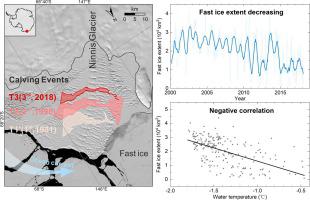International Journal of Applied Earth Observation and Geoinformation ( IF 7.5 ) Pub Date : 2021-11-12 , DOI: 10.1016/j.jag.2021.102612 Yuan Cheng 1 , Menglian Xia 1 , Gang Qiao 1 , Yanjun Li 1 , Gang Hai 1 , Da Lv 1

|
Iceberg calving is one of the contributing ways for the mass loss from ice shelves in Antarctica; the calving cycles of most ice shelves are quite long. The mechanism of iceberg calving has not been well investigated because of the limited temporal coverage of satellite observations. The Ninnis Glacier (NG) has experienced three calving events in the past 60 years (1980–1982, 1998, and 2018), which provides an opportunity to capture the long-term pattern of calving for the first time. In our study, ARGON, Landsat, and ERS-2 images were combined with field measurements to characterize the evolution of the Ninnis Glacier, especially for the last calving event, which can be studied using high-quality observations. The time span was over 23 years for the 1st calving cycle and the average time span was ∼18.5 years for each of the last two cycles. Supported by satellite-derived strain rates and ocean currents obtained from a numerical ocean model, we conclude that the calving of the Ninnis Glacier Tongue (NGT) was driven by the continuous impact of ocean current on the advected glacier tongue. According to a comparison among the three calving events, the calving area of the last calving event was ∼750 km2, only half of the 1st calving event, with breaking locations closer to the grounding line. We attribute these changes to the reduction of fast ice in this region, which can be related to the local oceanographic conditions.
中文翻译:

宁尼斯冰川过去 60 年的崩解周期
冰山崩解是南极洲冰架质量损失的原因之一;大多数冰架的产犊周期相当长。由于卫星观测的时间覆盖范围有限,冰山崩解的机制尚未得到很好的研究。宁尼斯冰川(NG)在过去 60 年(1980-1982、1998 和 2018 年)经历了 3 次产犊事件,这为首次捕捉长期的产犊模式提供了机会。在我们的研究中,ARGON、Landsat 和 ERS-2 图像与实地测量相结合,以表征 Ninnis 冰川的演变,特别是对于最后一次崩解事件,可以使用高质量的观测进行研究。第一个产犊周期的时间跨度超过 23 年,最后两个周期的平均时间跨度约为 18.5 年。在卫星衍生的应变率和从数值海洋模型中获得的洋流的支持下,我们得出结论,宁尼斯冰川舌 (NGT) 的崩塌是由洋流对平流冰川舌的持续影响驱动的。根据三个产犊事件的比较,最后一次产犊事件的产犊面积为~750 km2,只有第一次产犊事件的一半,断裂位置更靠近接地线。我们将这些变化归因于该地区快速冰的减少,这可能与当地的海洋条件有关。



























 京公网安备 11010802027423号
京公网安备 11010802027423号